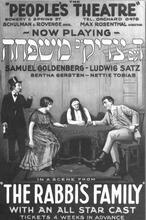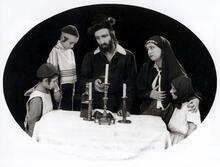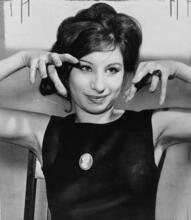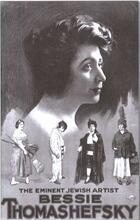Bella Bellarina
Bella Bellarina in an unidentified theater production. Photographer unknown / Museum of the City of New York. F2012.63.438
A star of the avant-garde Vilna Troupe, Bella Bellarina was beloved on the Yiddish stage, but her lack of English prevented her from transitioning to the mainstream theater. Bellarina began studying at the Warsaw School of Drama in 1916, where she was discovered by David Herman, the future director of the Vilna Troupe. He hired her for the troupe in 1918. In 1924, they debuted in New York, performing Yiddish classics as well as new plays. Bellarina was known for her range, playing the mischievous tomboy Tsine in Grine Felder and the reserved, ladylike Leah in The Dybbuk. She toured with various companies throughout the 1930s, but by the 1940s, Yiddish theaters began to close and Bellarina’s language barrier closed her off from English-language theater.
Unless they worked on the English-speaking stage, Yiddish actors were largely unnoticed by critics and the general media. Thus very little is known about the life of many of these wonderful artists who appeared before adoring audiences on the Lower East Side, Brooklyn, or the Bronx. Such is the case with Bella Bellarina, an actor who made her mark with the famous Vilna Troupe, a company dedicated to serious drama and avant-garde staging techniques.
Early Life
Bella (Rubinlicht) Bellarina was born in Warsaw on July 15, 1898. Her father, Getzl Rubinlicht, was a real estate broker. Her mother, Tuna (Vinover) Rubinlicht, was a homemaker who cared for sixteen children, four of whom died in early childhood. Bellarina was the fifth in order of birth. She attended a girls’ school, and at seventeen began taking classes in education at the university, presumably to become a teacher. Early on, however, she was drawn to the stage and appeared in various school productions.
In 1916, Bellarina enrolled in the Warsaw School of Drama. David Herman, future director of the Vilna Troupe, saw her perform there and urged her to join several drama clubs in the city, among them the renowned Artistisher Vinkl [Artists’ Corner].
Performance Career
Her first role on the Yiddish stage was Fanitchke in Sholem Aleichem’s play Mentshn [People]. In 1918, she became a member of the Vilna Troupe and toured in Europe for several years. In 1924, amid great anticipation, the company arrived in New York, where Bellarina was cast in such Yiddish classics as Ansky’s The Dybbuk, Peretz Hirschbein’s Di Puste Kretchme [The Idle Inn] and Grine Felder [Green fields], Jacob Gordin’s Mirele Efros, as well as works by Leon Kobrin and David Pinsky.
While in America, Bellarina and her husband, Haim Schneyer Hamerow, an actor with the Vilna Troupe, decided to stay. In New York, she worked with, among others, Maurice Schwartz, the legendary producer, director, and actor, founder of the Vilna-patterned Yidisher Kunst Teater. In 1929, Bellarina and Hamerow became American citizens, which allowed them to return to Poland and reclaim their son, Theodore, who had been in the care of Bellarina’s mother. The three returned to New York in 1930. Bellarina and Hamerow continued to tour for several more years with various companies in North and South America. However, the war and the steady decline of the Yiddish theater forced Hamerow into working in the garment district. Bellarina managed to survive by appearing at benefits and various social and cultural functions. Haim Hamerow died on July 24, 1961, and Bella Bellarina on February 1, 1969.
Career Successes
Bellarina played many important roles on the Yiddish stage, but she is best remembered for her portrayal of Tsine in Grine Felder and Leah in The Dybbuk. As Tsine, she played a peasant girl, a mischievous tomboy in love with a shy yeshiva student from a neighboring city. The role requires a great deal of energy and charm, and Bellarina had plenty of both. By contrast, Ansky’s classic calls for an actor who can play a reserved, deeply religious young woman, secretly in love with a man she cannot marry. Both characters are beautiful women, but while Tsine’s beauty is robust and earthy, Leah’s is delicate, even fragile. Tsine is a happy-go-lucky country girl; Leah is a tragic hero. Bellarina was successful in both roles. However, Helen Beverly and Lili Liliana are better known as Tsine and Leah because they were cast in the 1937 screen adaptations of the Hirschbein and Ansky plays. Another reason for Bellarina’s lack of popularity was her inability to play on the English-speaking stage and in English-language films. Critics agreed that her talents were equal to those of Esther Rokhl Kaminska, Ida Kaminska, Molly Picon, and Celia Adler—widely recognized names from the golden age of the Yiddish theater. Bellarina remained relatively obscure since she never appeared on Broadway or in Hollywood. Her obscurity, however, does not diminish her great contributions to Yiddish culture in the United States.
AJYB 71: 602.
Hamerow, Theodore [son of Bella Bellarina]. Telephone interviews with author.
Landis, Joseph, ed. and trans. The Great Jewish Plays (1972).
Lifson, David. Yiddish Theater in America (1965).
Obituary. NYTimes, February 2, 1969, 72:3.
Sandrow, Nahma. Vagabond Stars—A World History of the Yiddish Theater (1977).
Zylbercweig, Zalmen. Leksikon fun Yidishn Teater (1931).













